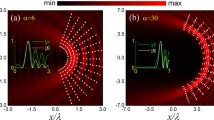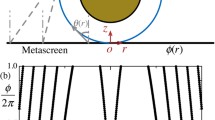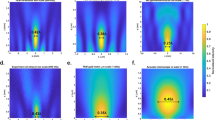Abstract
It has been demonstrated for the first time that an existence of acoustic analogue of photonic jet phenomenon, called acoustojet, providing for subwavelength localization of acoustic field in shadow area of arbitrary 3D penetrable mesoscale particle, is possible. Physical realizations of penetrable particle of arbitrary 3D shape are discussed.
Similar content being viewed by others
Avoid common mistakes on your manuscript.
The ability to control wave propagation is of fundamental interest in many areas of physics. But using conventional lenses, it’s not possible to focus sound waves to a spot size smaller than half the wavelength of the radiation due to diffraction. Currently, different groups of researches make attempts to overcome diffraction limit. Overcoming diffraction limit means focusing radiation into the spot with sizes less than Airy disk (Born and Wolf 1999; Randall 1951).
In acoustic some new ideas [in contrast to lenses from conventional (Neisius et al. 2014) and artificial (Kock 1969)] materials were considered at last time: a linear array of closely spaced sound transducers was offered to produce a subwavelength-focused intensity profile at a distance of a quarter wavelength (Abasi et al. 2011), to shape the flow of waves at subwavelength scales the metamaterials were investigated at Lemoult et al. (2013), Zhao et al. (2013), a broadband sounds can be also focused on a subwavelength scale using acoustic resonators (Lemoult et al. 2011), acoustic GRIN lens (Park et al. 2016), artificial impedance surface with spatially varying values (Lan et al. 2013) etc.
However, existing methods of subwavelength focusing in acoustics as a rule based on new artificial materials, or require complex signal processing methods.
From well-known Mie theory for spherical dielectric low losses particle scattering it is easy to see how the field enhancement transfer to pronounced “jet-like” structure near the outer part of the particle (Luk’yanchuk et al. 2000). It was demonstrated later that, when plane wave fell at spherical particle, spatial resolution could reach up to one-third of wavelength, which is lower than classical diffraction limit due to effect of so-called “photonic nanojet” (PNJ) (Chen et al. 2004). The review of current state on photonic jet formation by arbitrary shaped dielectric particles in electromagnetic spectrum is given in the work (Minin and Minin 2014).
At the same time in acoustics and ultrasound there is much tension around the issue of possibility of sub-wave focusing of acoustic and ultrasound fields. Thomas et al. (2009) an issue of plane acoustic wave focusing by spherical cavity (lens) filled with various gases was discussed. The Mie parameter of spherical particle was \(2\pi R/\lambda\) = (17.5… 27.5). It was noted (Thomas et al. 2009) that with small Mie parameters the location of focus near the shadow surface of spherical lens did not correspond to focal distance, prognosticated by geometrical optics theory.
On the other hand, in the linear mode it should be expected that methods of sub-wave focusing, based on photonic jet effect, can be successfully used in the acoustic range as well. Formally this can be stated based on the analogy between the equations, specifying acoustic and electromagnetic wave processes (see Table 1; Nicolas et al. 1998).
To shown the possibilities of acoustic analogue of photonic jet existences we examine multiply acoustic wave scattering at penetrable spherical particle (Minin and Minin 2016). The relevance of penetrable scaterers (Maurel et al. 2014; Chen and Kim 1967) in acoustics is recovering a renewed interest, where special interest appears for the case of low contrast systems (Laurel and Mercier 2012). By penetrable (Maurel 2014), as in Thomas et al. (2009), we mean that pressure waves may travel through the particle, that is, the particle is not rigid. The transmission loss as the wave travels through the particle is neglected. The problem of scattering on homogeneous limited area, placed inside the other homogeneous area, in the first approximation in the harmonic case, can be solved based on the Helmholtz equation (Kress 2001):
where the pressure p and the velocity u are: \({p\left( {x,t} \right) = R\left[ {u(x)e^{i\omega t} } \right]}\) and the wave number \(k\) is \({k = 2\pi /\lambda = \omega /c}\). Here \({\left( {\nabla } \right)}\)—is Laplace operator, R—is a real part of []. For permeable spherical particles represent the total field u on the boundary as the sum of three fields: the incident field of plane wave ui, the scattered field us and the field inside the particle ud. Approximately can be written: \({u_{i} + u_{s} = u_{d} }\).
The simulation self-developed program was coded in FORTRAN following the recommendations of the works (Thomas et al. 2009; David Colton et al. 2013). Preliminary simulation results of scalar acoustic wave scattering at penetrable sphere are as follows. The acoustic contrast (the relation of wave numbers or sound velocity in the sphere material to the medium) C = 1.1, relative density (sphere material density to medium density) in all examples below is 1.2, sphere radius is given in the units of wavelength in medium.
Simulations shown that dependences of maximal field intensity along the jet vs spherical particle radius is almost linear and changes from about 10 for particle with radius of 1 to 85 for particle with radius of 5 wavelength (Fig. 1).
In Table 2 the summary characteristics of forming acoustic jets from contrast of sound velocities in sphere and medium material are given, where Lz—the length of acoustic jet at Full Width at Half Maximum (FWHM), x—the acoustic beam waist at FWHM in the point of maximal field intensity P (pressure) along a jet. The values of Lz and x are given in the unit of wavelength in medium.
These results of modeling of acoustic plane wave scattering on penetrable sphere demonstrate that in the acoustic band a formation of acoustic analogue of photonic jet with subwavelength size is possible. Thus, as follows form the Table 2, with the parameter C = 1.2 the half-width of acoustic field intensity distribution in the jet area makes up 0.42 of wavelength, and with C = 1.4 it comprises 0.28 of wavelength, which agrees with analogous values for photonic jets of electromagnetic range by the order of values (Luk’yanchuk et al. 2000; Chen et al. 2004).
These results of modeling of acoustic plane wave scattering on penetrable sphere demonstrate that in the acoustic band a formation of acoustic analogue of photonic jet with subwavelength size is possible.
As practical example, formation of acoustojet for spherical particle (radius 5 of wavelengths) from lead placed in water is shown in the Fig. 2.
Formation of localized sub-wave zone of acoustic field in the conditions of significant reflection, caused by large value of sphere material density compared to environment, is clearly visible. Maximal intensity (pressure) in acoustic jet is over 60 times higher (in scalar approximation) than intensity of incident field. Experimental verification of acoustojet will be conducted in near future.
It is interesting to compare the photonic jet formation and characteristics from acoustic penetrable sphere and dielectric sphere in electromagnetic (optical) band. The simulation shown that the length of a jet (at FWHM) is 2.2, beam waist is 0.38 (all units are given in the wavelength) and maximal field intensity is 134. For scalar acoustic jet the parameters are as follows: the length is 1.51, beam waist 0.39, the maximal pressure is 60. It seems the parameters of a jet from acoustic and optics are similar. It could be noted that the principle difference between optical and acoustical materials properties is a shear speed of sound, i.e. acoustic materials are always anisotropic. But to demonstrate the fundamental possibility of the formation of an acoustic jet is sufficient to use a scalar approach, where the particles are assumed to be isotropic material.
In Lopes et al. (2016) based on the rigorous partial-wave expansion method the scattered pressure around the sphere were obtained. In case of a solid elastic sphere both compressional and shear waves were taken into account. Investigations show that for a 5λ-radius sphere with refractive index of about 1.6, the acoustic jet remains under the diffraction limit by approximately few wavelengths in depth, with an intensity gain close to 20 dB referenced to the incident intensity.
A physically realizable penetrable particle of arbitrary 3D shape may be designed as fluid-like structure (Cebrecos et al. 2014) or ‘acoustic metamaterial (Haberman 2016), which consists of a periodic arrangement of clusters (mesoscale scatterers) made itself of a periodic distribution of several identical rigid scatterers, all immersed in a fluid. In the long wavelength regime (in the homogenization limit, λ ≫ a, λ is the wavelength and a is the distance between the rigid scatterers within the cluster) the cluster can be considered as a fluid-like cylinder for acoustic waves with the following effective parameters (Torrent and Sánchez-Dehesa 2006).
where ρ0 and c0 are the density and sound velocity in the host material respectively and fs = Ss = Sc is the filling fraction of the cluster: Ss is the total area filled by the scatterers and Sc the area of the cluster.
There is reason to believe that discovered effect will be right for penetrable particles of arbitrary 3D shape as well, including also the reflection mode (Minin and Minin 2014). Application of the subwavelength acoustojet may be found in such areas as a miniature mesoscale acoustic lens, unique devices for microstructure examination and nondestructive testing based on acoustic microscopes (Briggs and Kolosov 2009; Yang et al. 2010), using which a microstructure of almost any optically opaque object can be investigated, acoustic traps of micro-particles (Baresch et al. 2016), biological sensors (Turner et al. 1989; Minin et al. 2011), nondestructive testing systems and acoustic imaging (Zakutailov et al. 2009), and so on.
In conclusion it could be noted the following. The main difficulty in applying the acoustic-electromagnetic analogy to a photonic jet is the different physical nature of scalar longitudinal acoustic field and transverse vectorial electromagnetic field used in 3D configuration (Colton et al. 2013). This causes certain complexity in the establishing direct link between the measurable parameters such as optical intensity and acoustic pressure. Nevertheless the concept shown in this work may offer a new way to focus sound waves into subwavelength spot size.
References
Abasi, R., Markley, L., Eleftheriades, G.V.: Experimental verification of subwavelength acoustic focusing using a near-field array of closely spaced elements. J. Acoust. Soc. Am. 130(6), 405–409 (2011)
Baresch, D., Thomas, J.-L., Marchiano, R.: Observation of a single-beam gradient force acoustical trap for elastic particles: acoustical tweezers. Phys. Rev. Lett. 116, 024301 (2016)
Born, M., Wolf, E.: Principles of Optics, 808 pp. Cambridge University Press, New York (1999)
Briggs, A., Kolosov, O.: Acoustic Microscopy, 357 pp. Oxford University Press, New York (2009)
Cebrecos, A., Romero-García, V., Picó, R., et al.: Acoustically penetrable sonic crystals based on fluid-like scatterers. J. Phys. D Appl. Phys. 48(2), 025501 (2014)
Chen, Y.-M., Kim, S.-J.: Scattering of acoustic waves by a penetrable sphere with statistically corrugated surface. J. Acoust. Soc. Am. 42, 1–5 (1967)
Chen, Z.G., Taflove, A., Backman, V.: Photonic nanojet enhancement of backscattering of light by nanoparticles: a potential novel visible-light ultramicroscopy technique. Opt. Express 12, 1214–1220 (2004)
Colton, D., Kress, R.: Inverse Acoustic and Electromagnetic Scattering Theory, 388 pp. Springer, Berlin (2013)
Haberman, M.R.: Acoustic metamaterials. Acoust. Today 12(3), 31–39 (2016)
Kock, W.E.: Acoustics and optics. Appl. Opt. 8(8), 1525–1531 (1969)
Kress, R.: Acoustic scattering. In: Pike, E.R., Sabatier, P.C. (eds.) Scattering and Inverse Scattering in Pure and Applied Science, pp. 142–161. Academic, London (2001)
Lan, L., Jiang, W., Ma, Y.: Three dimensional subwavelength focus by a near-field plate lens. Appl. Phys. Lett. 102, 231119 (2013)
Laurel, A., Mercier, J.-F.J.: Propagation of guided waves through weak penetrable scatterers. Acoust. Soc. Am. 131, 1874–1889 (2012)
Lemoult, F., Fink, M., Lerosey, G.: Acoustic resonators for far-field control of sound on a subwavelength scale. Phys. Rev. Lett. 107(6), 064301 (2011). doi:10.1103/PhysRevLett.107.064301
Lemoult, F., Kaina, N., Fink, M., Lerosey, G.: Wave propagation control at the deep subwavelength scale in metamaterials. Nat. Phys. 9, 55–60 (2013)
Lopes, J.H., Leão-Neto, J.P., Minin, I.V., Minin, O.V., Silva, G. T.: A theoretical analysis of acoustic jets. In: Proceedings of the 22nd International Congress on Acoustics, Buenos Aires, Argentina, September 5–9, 2016. Paper ICA2016-943
Luk’yanchuk, B., Zheng, Y.W., Lu, Y. F.: Laser cleaning of solid surface: optical resonance and near-field effects. In: Proc. SPIE, vol. 4065, pp. 576–587 (2000)
Maurel, A., Mercier, J.-F., Felix, S.: Wave propagation through penetrable scatterers in a waveguide and through a penetrable grating. J. Acoust. Soc. Am. 135, 165–174 (2014)
Minin, I.V., Minin, O.V. (eds.): Ultrasound Imaging—Medical Applications. InTech, Chroatia (2011). doi:10.5772/689
Minin, I.V., Minin, O.V.: Photonics of isolated dielectric particles of arbitrary 3D shape—a new direction of optical information technologies. Vestnik NSU 12, 59–70 (2014)
Minin, I.V., Minin, O.V.: Acoustojet: acoustic analogue of photonic jet phenomenon. arXiv:1604.08146 (2016)
Neisius, A., Smith, N.B., Sankin, G., Kuntz, N.J., Madden, J.F., Fovargue, D.E., Mitran, S., Lipkin, M.E., Simmons, W.N., Preminger, G.M., Zhong, P.: Improving the lens design and performance of a contemporary electromagnetic shock wave lithotripter. Proc. Natl. Acad. Sci. USA 111(13), E1167–E1175 (2014)
Nicolas, L., Furstoss, M., Galland, M.A.: Analogy electromagnetism-acoustics: validation and application to local impedance active control for sound absorption. Eur. Phys. J. Appl. Phys. 4, 95–100 (1998)
Park, C.M., Kim, C.H., Park, H.T., Lee, S.H.: Acoustic gradient-index lens using orifice-type metamaterial unit cells. Appl. Phys. Lett. 108, 124101 (2016)
Randall, R.H.: An Introduction to Acoustic, 340 pp. Dover Publisher, New York (1951)
Thomas, C., Gee, K.L., Turley, R.S.: A balloon lens: acoustic scattering from a penetrable sphere. Am. J. Phys. 77, 197–203 (2009)
Torrent, D., Sánchez-Dehesa, J.: Effective parameters of clusters of cylinders embedded in a nonviscous fluid or gas. Phys. Rev. B 74, 224305 (2006)
Turner, E., Kraube, I., Wilson. J.: Biosensors Fundamentals and Applications, 770 pp. Oxford University Press (1989)
Yang, X., Cai, X., Maslov, K., Wang, L., Luo, Q.: High-resolution photoacoustic microscope for rat brain imaging in vivo. Chin. Opt. Lett. 08(06), 609–611 (2010)
Zakutailov, K.V., Levin, M.V., Petronuk, U.S.: High resolution ultrasound methods: microstructure visualization and diagnostics of modern material elastic properties (review). Factory Lab. 75(8), 28–34 (2009)
Zhao, J., Li, J., Chen, B., Qiu, Z., Wei, C.: Manipulating acoustic wavefront by inhomogeneous impedance and steerable extraordinary reflection. Sci. Rep. (2013). doi:10.1038/srep02537
Author information
Authors and Affiliations
Corresponding author
Rights and permissions
About this article
Cite this article
Minin, O.V., Minin, I.V. Acoustojet: acoustic analogue of photonic jet phenomenon based on penetrable 3D particle. Opt Quant Electron 49, 54 (2017). https://doi.org/10.1007/s11082-017-0893-y
Received:
Accepted:
Published:
DOI: https://doi.org/10.1007/s11082-017-0893-y






